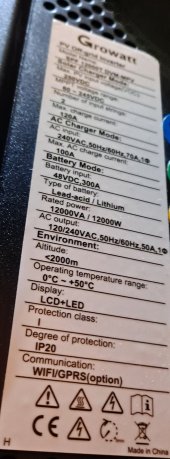I know this has been asked, but every thread I read always deals with a lower output inverter. I have the 12KW All In One Growatt Inverter. The sticker on the side of the unit says it is rated for 300A of battery input at 48VDC.
Here's my setup:
1. I have 4x48v LifePO4 100AH batteries.
2. Batteries are to be installed on the open battery server rack from Signature Solar, which has busbars.
3. The battery rack will be connected from the busbars to the inverter.
Each battery came with a 6 AWG wire, which as far as I can tell seems to be correct since I'm connecting these all to the busbar in parallel. However, I can't for the life of me find out what cable size I need for the batteries to the inverter. It sounds like I need to support 300A (and, from what I understand, a little more for safety). But this chart doesn't go beyond 200A: https://www.bluesea.com/resources/1437
In fact, most charts don't seem to. Am I missing something obvious here?
Also, my understanding is I should use a 320A inline T-Class Fuse on the positive cable between the inverter and battery rack. Is this correct?
Thanks for your help.
Here's my setup:
1. I have 4x48v LifePO4 100AH batteries.
2. Batteries are to be installed on the open battery server rack from Signature Solar, which has busbars.
3. The battery rack will be connected from the busbars to the inverter.
Each battery came with a 6 AWG wire, which as far as I can tell seems to be correct since I'm connecting these all to the busbar in parallel. However, I can't for the life of me find out what cable size I need for the batteries to the inverter. It sounds like I need to support 300A (and, from what I understand, a little more for safety). But this chart doesn't go beyond 200A: https://www.bluesea.com/resources/1437
In fact, most charts don't seem to. Am I missing something obvious here?
Also, my understanding is I should use a 320A inline T-Class Fuse on the positive cable between the inverter and battery rack. Is this correct?
Thanks for your help.



